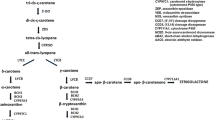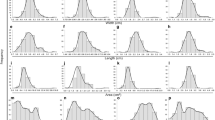Abstract
High carotenoid potato may have particular value for human health due to the antioxidant properties and the therapeutic value for eye health in patients at risk for macular degeneration. Carotenoid concentrations were determined among the progeny of a cross between two high carotenoid lines derived from diploidPapa Amarilla germplasm from South America. The total carotenoid content ranged from 82 to 2686 µg / 100 g fresh weight (FW). The higher values greatly exceeded the mid-parent value of the cross. An index for yellow tuber flesh color was determined for a subset of the progeny. A cleaved amplified polymorphic sequence (CAPS) assay was developed to distinguish the alleles of beta-carotene hydroxylase (bch) in the two high-carotenoid parents. Abch allele (denoted B) common to the high carotenoid parents co-segregated with yellow flesh in the progeny of a white-flesh x yellow-flesh cross, makingbch an excellent candidate for the classicalY locus, required for yellow tuber flesh. The same allele was also present in all other yellow-fleshed potato clones tested. Genotype atbch explained a portion of the variation of total carotenoid (R2=0.42). Clones homozygous for the B allele (BB) contained, on average, slightly more carotenoid than heterozygous Bb clones, which in turn had much more carotenoid than homozygous bb clones, suggesting a partially dominant gene model. Similarly, bb flesh was significantly less yellow than Bb and BB, the latter two being quite close. Total carotenoid varied considerably between progeny in the Bb and BB genotype categories, suggesting that variation at one or more additional loci have a significant effect on total carotenoid levels. Since the total carotenoid levels in manyPapa Amarilla cultivars and progeny are much higher than those in white- and yellow-fleshed tetraploid cultivars, it may be possible to breed for high carotenoid values in tetraploid germplasm by introducing one or more genes derived fromPapa Amarilla germplasm.
Resumen
Las papas con alto contenido de carotenoides podrían tener particular valor en la salud humana debido a las propiedades antioxidantes y al valor terapéutico para la salud ocular, en pacientes con riesgo de degeneración macular. La concentración de carotenoides fue determinada en la progenie de un cruzamiento entre dos lineas con carotenoides, derivadas de germoplasma del diploide Papa Amarilla de Sudamérica. El contenido total de carotenoides varió de 82 a 2686 microgramos por 100g de peso fresco. Los mayores valores totales excedieron al valor del progenitor medio de los cruzamientos. Para un subconjunto de la progenie, se determinó el índice del color amarillo de la pulpa. Se desarrolló una prueba de división de secuencia polimórfica amplificada (CAPS) para distinguir alelos de beta caroteno hidroxilasa (bch) en dos de los progenitores con alto contenido carotenoideo. Un alelobch (designado B), común en progenitores de alto caroteno co-segregó a pulpa amarilla en la progenie de un cruzamiento de pulpa blanca x pulpa amarilla, haciendobch un excelente candidato para el clásico locusY, requerido para pulpa amarilla del tubérculo. El mismo alelo estuvo también presente en todos los otros clones de pulpa amarilla probados. La explicación de la variación de una porción del total de carotenoide (R2=0.42) la dio el genotipobch. Clones homocigotas para el alelo B (BB) contenían en promedio, ligeramente mas carotenoide que los clones heterocigotas Bb, los cuales a su vez tienen mucho mas carotenoide que los clones homocigotas bb, sugiriendo un modelo de gen parcialmente dominante. Similarmente, la pulpa de bb fue significativamente menos amarilla que Bb y BB, siendo las dos últimas muy parecidas. El total de carotenoide varió considerablemente entre progenies en las categorías de genotipo Bb y BB, sugiriendo que la variación en uno o más loci, tienen efecto significativo sobre los niveles totales de carotenoide. Desde que el total del nivel de carotenoide en muchos cultivares y progenies de Papa Amarilla son mucho mas altos que en los cultivares tetraploides de pulpa blanca y amarilla, sería posible hacer cruzamientos para mayores valores de carotenoide en el germoplasma tetraploide, introduciendo uno o mas genes del germoplasma derivado de Papa Amarilla.
Similar content being viewed by others
Literature cited
American Society for Testing Materials. 1991. ASTM Standards on Color and Appearance. 3rd ed. Amer Soc Testing Materials, Philadelphia. pp 239–242.
Boniebale MW, RL Plaisted and SD Tanksley. 1988. RFLP maps based on a common set of clones reveal modes of chromosomal evolution in potato and tomato. Genetics 120:1095–1103.
Breemen RB van. 2001. Carotenoid.In: RE Wrolstad (ed), Current Protocols in Food Analytical Chemistry. Wiley, New York. pp F2.1-F2.4.6.
Brown CR. 2005. Antioxidants in potato. Amer J Potato Res 82:163–172.
Brown CR, CG Edwards, C-P Yang and BB Dean. 1993. Orange flesh trait in potato: Inheritance and carotenoid content. J Amer Soc Hort Sci 118:145–150.
Brown, CR, D Culley, C-P Yang, R Durst and R Wrolstad. 2005. Variation of anthocyanin and carotenoid contents and associated antioxidant values in potato breeding lines. J Amer Soc Hort Sci 130:174–180.
Brunstetter BC and HG Wiseman. 1947. Carotenoid pigments in tubers of the Katahdin variety of Irish potatoes. Plant Physiol 22:421–437.
Caldwell JS, BC Brunstetter, CW Culpepper and BD Ezell. 1945. Causes and control of discoloration in dehydration of white potatoes. Canner 100(13):35.
Hale AL. 2003. Screening potato genotypes for antioxidant activity, identification of the responsible compounds, and differentiating Russet Norkotah strains using AFLP and microsatellite marker analysis. PhD dissertation, Texas A&M University, College Station.
Haynes KG. 2000. Inheritance of yellow-flesh intensity in diploid potatoes. J Amer Soc Hort Sci 129:63–65.
Haynes KG, WE Potts, JL Chittams and DL Fleck. 1994. Determining yellow-flesh intensity in potatoes. J Amer Soc Hort Sci 119:1057–1059.
Hirschberg J. 2001. Carotenoid biosynthesis in flowering plants. Curr Opin Plant Biol 4:210–218.
Iwanzik W, M Tevini, R Stute and R Hilbert. 1983. Carotinoidgehalt und Zusammensetzung verschiedener deutscher Kartoffelsorten und deren Bedeutung fur die Fleischfarbe der Knolle. Potato Res 26:149–162.
Kasim M. 1967. Beitrag zur qualitativen analyse der carotinoide von kartofflen. Tinode Nahrung 11:411–415.
Lu WH, K Haynes, E Wiley and B Clevidence. 2001. Carotenoid content and color in diploid potatoes. J Am Soc Hort Sci 126:722–726.
Morris WL, L Ducreux, DW Griffiths, D Stewart, HV Davies and MA Taylor. 2004. Carotenogenesis during tuber development and storage in potato. J Exper Bot 55:975–982.
Nesterenko S and KC Sink. 2003. Carotenoid profiles of potato breeding lines and selected cultivars. HortScience 38:1173–1177.
Römer S, J Lübeck, F Kauder, S Steiger, C Adomat and G Sandmann. 2002. Genetic engineering of a zeaxanthin-rich potato by antisense inactivation and co-suppression of carotenoid epoxidation. Metabol Engin 4:263–272.
Steel RGD and JH Torrie. 1980. Principles and procedures of statistics: A biometrical approach. McGraw-Hill, New York.
Tevini M, W Iwanzik and G Schonecker. 1984. Analyse vorkommen und nerhalten von carotinoiden in kartoffeln und kartoffelprodukten. Jahrbuch Forschungskreis Ernahrungsindustrie V 5:36–53.
Tevini M and G Schonecker. 1986. Occurrence, properties, and characterization of potato carotenoids. Potato Res 29(2):265.
Thorup TA, B Tanyolac, KD Livingstone, S Popovsky, I Paran and M Jahn. 2000. Candidate gene analysis of organ pigmentation loci in the Solanaceae. Proc Natl Acad Sci USA 97:11192–11197.
Author information
Authors and Affiliations
Corresponding author
Rights and permissions
About this article
Cite this article
Brown, C.R., Kim, T.S., Ganga, Z. et al. Segregation of total carotenoid in high level potato germplasm and its relationship to beta-carotene hydroxylase polymorphism. Am. J. Pot Res 83, 365–372 (2006). https://doi.org/10.1007/BF02872013
Accepted:
Issue Date:
DOI: https://doi.org/10.1007/BF02872013




